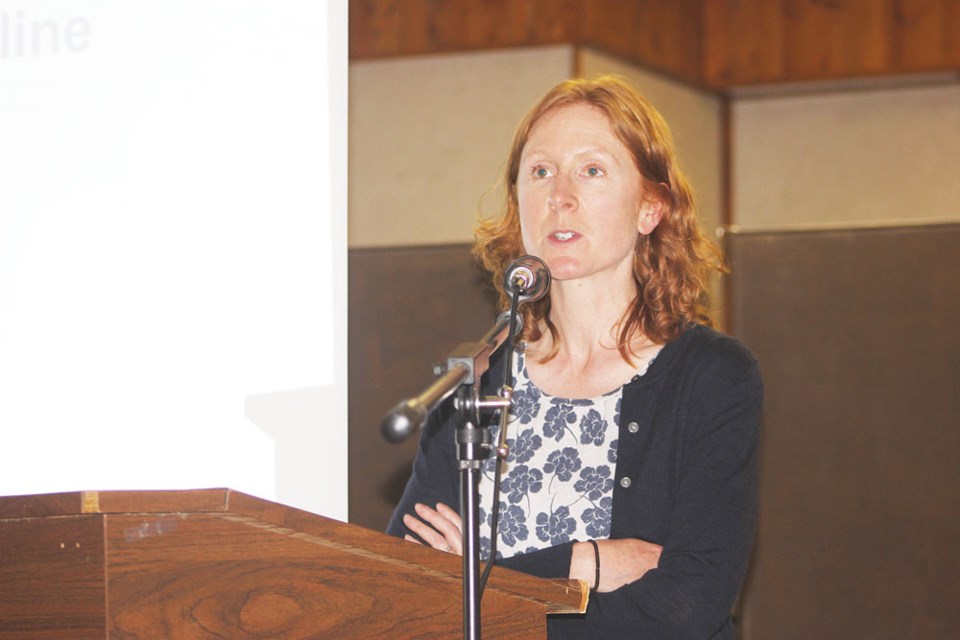Residents from both sides of Canada-U.S. border gathered in Estevan on June 25 to discuss issues related to the Souris River.
A public meeting of the International Souris River Board was held at the Days Inn’s Taylorton Room, with about 100 people in attendance. They heard presentations about the river and its management, and then a few people stood up to voice concerns with the river.
Nicole Armstrong, who is the Canadian co-chair of the board, said the organization tries to alternate its meeting locations throughout the Souris River watershed, with get-togethers in both Canada and the U.S.
“Our last meeting in the winter was in Minot, and we had a public meeting and invited folks from the U.S. to come and meet with us,” said Armstrong. “So we thought it was a good chance to meet on the Canadian side, and talk to folks in Estevan.”
Among the speakers was John Fahlman with the Saskatchewan Water Security Agency, who discussed the water management side from a Saskatchewan perspective.
He noted there are three reservoirs in the Estevan area, with one of them, Boundary Dam, used for water supply purposes, except for in a flood situation. He called the other two – Rafferty Dam and Grant Devine Lake (formerly Alameda Dam) – multipurpose reservoirs.
Fahlman noted that Grand Devine Lake and Rafferty Dam are drawn down a metre beneath their full supply level (FSL) each spring to provide flood protection, regardless of the forecast or the snow levels.
In the case of the past 12 months, last year was a dry summer and fall, which reduces runoff potential even if there’s a lot of snow. But this past winter also had a well below normal snow pack.
“The runoff generally began in the basin in mid-April,” said Fahlman. “The actual … runoff came in even lower than the forecast.”
The diversion channel from Boundary Dam to Rafferty Dam was not used.
The southeast has received more precipitation this spring, most notably the Lampman area in early June, which resulted in greater inflows for Grant Devine Reservoir. They had to release two cubic metres per second from the lake for a couple of weeks last month, but those releases came to an end on June 25.
Three people took advantage of the opportunity to address the board during the meeting. One of them was Jack Twietmeyer of Oxbow, a director with the Upper Souris Watershed Association who is concerned with water quality and aquatic invasive species.
“In Saskatchewan so far, we don’t seem to have them in any of our water bodies, but I really have a concern that we might get them,” he said.
He wants to see every possible action taken to prevent it from happening. Zebra mussels are a particular threat to water bodies.
“I would like to see any watercraft coming into the province be examined and checked out before it’s allowed into our reservoirs, but so far it’s not the law that it has to happen,” said Twietmeyer.
The board knows what invasive species can do, and they can’t fix the problem once those species are in the reservoirs, he said.
Two Americans also spoke at the meeting. Leland Goodman, who resides north of Towner, N.D., voiced his concerns with the water management efforts, on both sides of the border. He questioned whether the flood of the Souris River in 2011, which impacted residents of Saskatchewan, North Dakota and Manitoba, was due to the snow pack that year and the “combined action of releases.”
Flood control is necessary for the area to survive, he said. But in 2011, areas of North Dakota were sacrificed to mitigate the flood damage in Minot.
“In doing that, there were a lot of detrimental things that happened,” he said.
The areas downstream of Minot weren’t a concern, he said.
Goodman said the flood of 2011 was foreseeable because of snow pack, and he predicted there would be another flood at some point in the future.
Paul Smetana from Lansford, N.D., told the board that he has concerns associated with water quality. In particular, he noted that tile drainage started in his area last fall.
“When they started it, they told me the reason for tile drainage is because the water would go down, they would lower the water table and they would get the salts out of the soil to go into the water, and they would rid of the salts from their land,” he said.
But Smetana said there was already a high saline content in the water, and if salt is added to the water, it will be even higher salt content.
Armstrong said she was pleased with the turnout for the meeting, and the concerns about aquatic invasive species, water quality and tile drainage.
“It’s great for the board to hear that kind of information, and we can take that back and talk about it at our board meeting tomorrow,” said Armstrong.
She recognized a few people from the U.S. who come to their public meetings, and she was glad to see a few Canadians in attendance as well.
Protecting aquatic ecosystem health is a big part of their mandate, she said, and some invasive species can become problematic for natural aquatic life in a river or stream.
The board remained in Estevan for a meeting on June 26, when they discussed what they heard at the open forum, and some of the other topics facing the river.
Work is also ongoing on the International Souris River Study that is looking at flood mitigation, the international agreement between the two countries and how the reservoirs are operated. The comments from the June 25 meeting will be taken into consideration for that study, which is expected to be completed in 2020.




